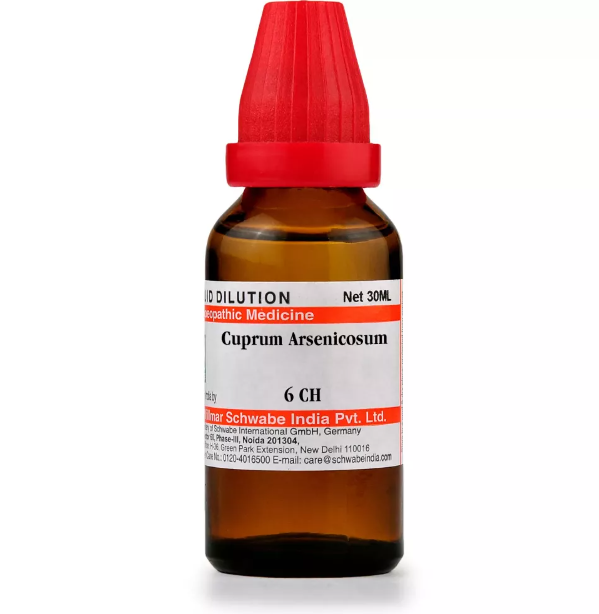CUPRUM ARSENICOSUM 3x, 6x, 12x, 6C, 12C, 30C, 200C, 1M, 10M USES AND SYMPTOMS
 CUPRUM ARSENICOSUM
CUPRUM ARSENICOSUM
(Arsenite of Copper, Scheele’s Green)
Cupr-ar.
A remedy for symptoms due to poor kidney function, intestinal issues, cholera morbus and infantum, enterocolitis, diarrhea, and dysentery. Treats gastrointestinal issues in influenza and typhoid, uremic convulsions, headaches, vertigo, and unconsciousness from brain edema, pregnancy nephritis, convulsions with gastrointestinal symptoms, chlorosis, bronchial asthma with emphysema, purulent endocarditis (Royal), painful neuroses, enteroptosis, delirium, and tremor cordis (chorea).
Mouth: Thickly coated tongue, dirty brown or white, metallic taste, thirst, dry mouth.
Abdomen: Gastroenteritis, severe abdominal pain, diarrhea in phthisis, cholera (Ars., Verat., Camph.), rumbling and sharp cutting pain, dark liquid stools.
Urinary: Renal inefficiency, uremia, garlicky odor, diabetes, urine with high specific gravity, increased acetones and diacetic acid.
Male: Persistent scrotal perspiration, boils on the scrotum, purulent white discharge from the urethra (gleet), tingling and burning in the urethra (urethritis), pain in the prostate and penis (syphilis).
Heart: Altered cardiac rhythm and force due to poor elimination.
Back: Persistent lameness, pain in the lumbar region and lower part of the left shoulder blade, tight chest.
Extremities: Calf cramps, worse after midnight, relieved by standing, ulcers, gangrene.
Skin: Icy cold (hypothermia), intermittent cold clammy perspiration, acne, pustules on the face and in the cruro-genital region, chancre-like ulcers, gangrene, carbuncles.
SYMPTOMS OF CUPRUM ARSENICOSUM
Mouth:
Thickly coated tongue (dirty brown or white)
Metallic taste
Thirst
Dry mouth
Abdomen:
Gastroenteritis
Severe abdominal pain
Diarrhea in phthisis
Cholera
Rumbling and sharp cutting pain
Dark liquid stools
Urinary:
Renal inefficiency
Uremia
Garlicky odor
Diabetes
Urine with high specific gravity
Increased acetones and diacetic acid
Male:
Persistent scrotal perspiration
Boils on the scrotum
Purulent white discharge from the urethra (gleet)
Tingling and burning in the urethra (urethritis)
Pain in the prostate and penis (syphilis)
Heart:
Altered cardiac rhythm and force due to poor elimination
Back:
Persistent lameness
Pain in the lumbar region and lower part of the left shoulder blade
Tight chest
Extremities:
Calf cramps, worse after midnight, relieved by standing
Ulcers
Gangrene
Skin:
Icy cold (hypothermia)
Intermittent cold clammy perspiration
Acne
Pustules on the face and in the cruro-genital region
Chancre-like ulcers
Gangrene
Carbuncles
selection of the potency
Individualization:
- Homeopathy is based on the principle of treating the individual, not just the disease. The unique symptoms and characteristics of the person are crucial in determining the most suitable potency.
Intensity of Symptoms:
- The intensity of the symptoms guides the choice of potency. If the symptoms are intense and acute, a lower potency (e.g., 6C, 30C) might be considered. For chronic conditions with less intensity, higher potencies (e.g., 200C, 1M) may be appropriate.
Sensitivity of the Patient:
- Some individuals are more sensitive to homeopathic remedies, while others may require higher potencies. The practitioner considers the patient’s sensitivity when selecting the potency.
Acute vs. Chronic Conditions:
- Lower potencies are often used for acute conditions, while higher potencies may be considered for chronic or long-standing issues.
Previous Response to Potencies:
- The patient’s response to previous homeopathic treatments helps guide the choice of potency. If a particular potency has been effective in the past, it may be repeated or adjusted as needed.
Vital Force and Susceptibility:
- Homeopathy views illness as a disturbance in the vital force. The practitioner assesses the patient’s overall vitality and susceptibility to determine the appropriate potency.
Aggravation or Amelioration:
- The direction of the symptom response (aggravation or amelioration) after taking a remedy can influence the choice of potency.
Miasmatic Considerations:
- In classical homeopathy, the concept of miasms (inherited disease tendencies) is considered. The practitioner take this into account when selecting the potency.
Practitioner Experience:
- The experience and preference of the homeopathic practitioner play a role. Some practitioners may have success with certain potencies based on their clinical experience.
SAFETY INFORMATION
- Do not exceed the recommended dose by physician
- Keep out of the reach of children
- Store in a cool dry place away from direct sunlight
- Maintain half an hour gap between food/drink/any other medicines and homoeopathic medicine
- Avoid any strong smell in the mouth while taking medicine e.g. camphor, garlic, onion, coffee, hing
Medicine images use for reference only selection of homeopathic medicine depends on the individual’s specific symptoms and overall constitution. Moreover, homeopathy is a holistic system of medicine that treats the individual as a whole. In addition to addressing the physical symptoms, it takes into account the emotional and mental state of the person. Consequently, it’s crucial to consult with a qualified homeopathic practitioner for personalized treatment.
The information provided on this website is intended solely for educational purposes. Always seek the advice of your physician or other qualified health provider.
